Across print and digital, newspaper customers are turning away
 Today’s newspaper and digital subscriber numbers are the worst yet, says Mumbrella’s Tim Burrowes.
Today’s newspaper and digital subscriber numbers are the worst yet, says Mumbrella’s Tim Burrowes.
Soon I’m going to stop writing about this each time the quarterly numbers come out. It’s too depressing.
The signals get clearer. Newspapers’ final days in print are approaching, particularly for those in the Fairfax stable. Yet the evidence is now making clear that paywalls will not take up the slack.
I see a new sign most days.
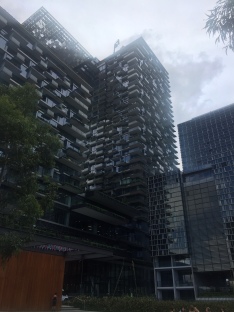
The only subscriber in the village
I rent in a new building. People familiar with Sydney might know it – it’s the one with the weird mirror and plants up the side of it, on Broadway.
If I look down, I can see the building across the road that for many years was the headquarters of the Sydney Morning Herald. And if I look out to the far western horizon, I can see where the readers of the Daily Telegraph live.
The guy on the front desk pointed out something depressing the other day. Of the 500 or so apartments, I am the only one who has a daily newspaper delivered.
It’s full of young students from the nearby university which doesn’t make them likely subscribers. But nonetheless, it’s the most depressing sign of the times for the print industry I can think of.
Earlier this week, I picked up a copy of the Australian Financial Review from the supermarket under the building. I went through the self service checkout and my AFR was so light that after I scanned it, the machine couldn’t detect it when I put it in the bag.
The flatplan is of course determined by the number of display ads, and when there aren’t any, the paper becomes too thin for those till scales to detect.
As the year got under way, I began a grim game, looking each day to see whether the Sydney Morning Herald had yet had a full page ad.
Even this week there was at least one day where the only full page ads were house inventory to promote the new joint venture streaming service with Nine, Stan.
According to Standard Media Index’s roundup of ad spend for 2014, something like $127m disappeared from newspaper advertising spend last year. Given that News Corp just reported to the financial markets that its horrible plummet in revenues has eased off, I presume that much of that impact will have been on Fairfax.
As a reader I vacillate between sympathy for that disappearing business model and indignation at being taken for granted.
In December, the Sydney Morning Herald’s editor in chief Darren Goodsir was a guest on the excellent Media Week podcast. It may not have been the impression he meant to give, but he came across as hugely complacent about his remaining print subscribers. “Rusted on” was the phrase he used more than once. Which as a rusted on subscriber, doesn’t half make you feel taken for granted.
And that’s a feeling that gets stronger when you pick up a Fairfax paper the morning after a big news or sporting event. As a money saving move, there’s now just one edition which I guess goes to press at about 6pm at best.
The morning after the Socceroos won the Asian Cup in one of the team’s greatest ever moments and the Liberals were routed in the Queensland election, which paper do you think would have attracted casual readers? (Clue: Not the one that couldn’t cover the football and thought the election was still a cliffhanger.)
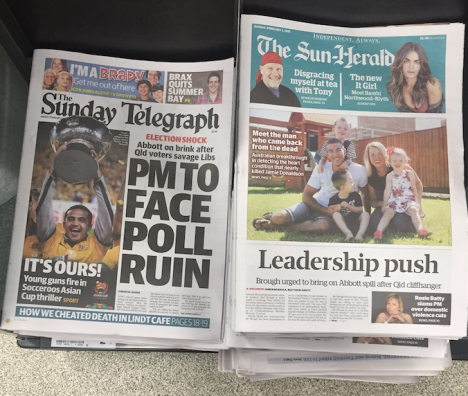
Nights like that must break the hearts of Fairfax journos when they know they’re going to be murdered by the later editions of the News Corp titles.
And then independent Fairfax journalism reminds me why I still subscribe. This week, Michael West’s work on Google’s morally dubious Australian tax arrangements; last week Nick McKenzie’s piece on police corruption. And in truth, despite my grumbling, for as long as investigative journalist Kate McClymont continues to write for the paper, I know I won’t be able to bear to cancel my subscription. Dammit, Goodsir, I am rusted on.
So what of the digital outlook?
Today’s data contained another depressing first.
Those whose job it is to talk up the industry often claim that when you add in digital subscriptions (and ignore that they bring in much smaller revenues), overall paying audiences are up.
That ended today.
The combined print and digital audience fell for every single daily and weekend metro and national paper in the audit.
This table removes the double counting of print subscribers who don’t even know they are digital subscribers (more on that below). As you’ll see when you add the three types of subscriber – print-only, digital-only and print-digital packages – not a single masthead has grown.

Combined masthead audiences
By my reckoning, newspapers have fewer paying customers than at any point in the last half century or more.
It gets worse yet for News Corp’s Victorian title the Herald Sun. It became the first newspaper to see its digital subscriber numbers record a negative number compared to the previous quarter – down from 50,360 to 49,425. (It should also be noted that News Corp’s other big tabloids have never taken part in the digital audit – most likely because their numbers are embarrassingly small).
News Corp’s The Australian grew by just 173 digital subscribers.
And Fairfax Media’s SMH and The Age only showed their small digital growth of 1.75 percent and 1.38 percent with what is, I suspect, some significant jiggery-pokery.
I, for instance, subscribe to the seven day print edition of the SMH. I never asked about digital access and they didn’t mention it when they sold the package to me.
Yet subsequent customer service emails indicated that I count as both a print and digital subscriber. So I helped drive that small digital growth statistic, despite not actually having successfully logged into the website as a subscriber.
Over the years, I’ve tended to be somewhat sceptical about the SMH’s claims over subscriber numbers. We shot this video in 2010 when someone told me where to find a mysterious pile of SMHs.
https://www.youtube.com/watch?v=4Bea_TIGQFI
Which isn’t to say that I don’t access the SMH online. But the paywall is so easy to subvert with a quick hop into Google Chrome’s incognito mode, that it’s easier than getting your subscriber details, which is something of a trial.
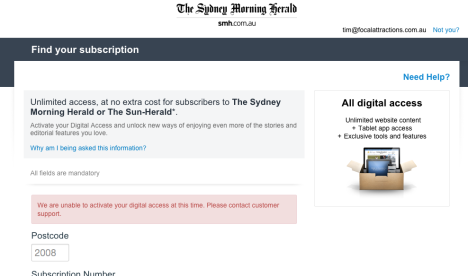 That process is so Kafkaesque and comical, that they’d have been better off not bothering.
That process is so Kafkaesque and comical, that they’d have been better off not bothering.
Indeed, so bad is is the activation process that it actually gives me some hope that if Fairfax ever invested in getting it right, then the company may keep or convert more digital subscribers.
I won’t bore you with the whole process. Suffice to say that it involves needing to get a digital subscriber number (which they don’t automatically email to you), a system which locks you out when you put in your home address (if you don’t guess the format correctly) before urging you to call for assistance (on a number that isn’t provided).
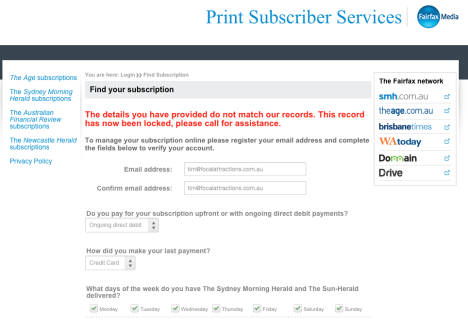
If you do track down the phone number, you’ll be greeted with a recording telling you that you’ll half to wait 40 minutes to speak to a human or submit a query via the website.
At which point you are asked to fill out a lengthy form whose mandatory fields are more exacting than many countries’ tax returns, including irrelevant questions about delivery suspension, my “origin” (um, England?), company name, industry and whether I have a newspaper subscription. And fuck knows what I’m supposed to put in the field labelled LL_data, [DATA] Browser, [Data] Browser Version and [Data] Browser Engine.
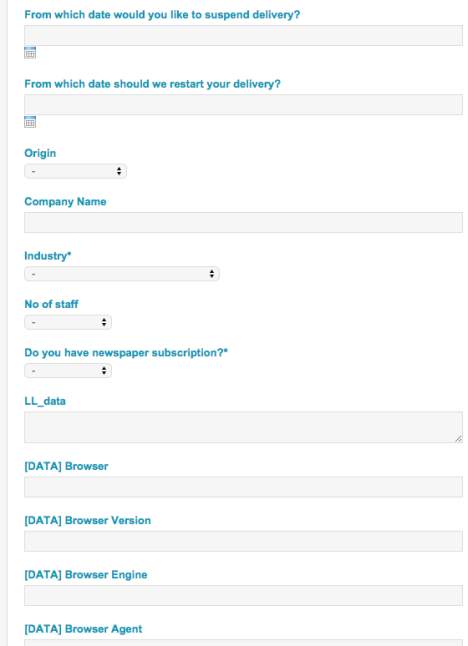
Only then do you get to to proceed to another field to tell them what your question is, via one of the largest dropdowns of different ways newspapers can be rubbish that I’ve ever seen.
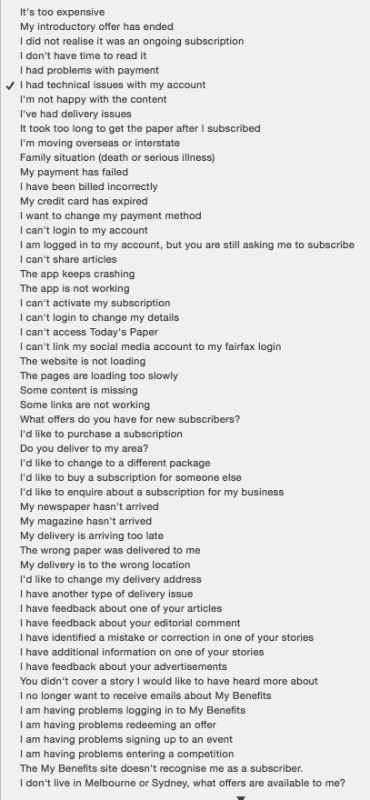
After selecting from more than 60 options including objections to the cost, dislike of the content, problems loading pages or the app constantly crashing, the new subscriber may be wondering just what the hell they’ve got themselves into.
Or like me they may just give up at this point, activate Google Chrome’s incognito mode and carry on reading for free anyway, even after my subscriber number did eventually arrive.
Not too surprisingly, the newspaper and print industry prefers now to talk about the softer metric of readership rather than circulation – as calculated by the EMMA survey which is conducted by Ipsos and paid for by those industry players. Broadly, it’s done by asking the online public what titles they remember reading, and taking that recollection at face value.
I see that Bauer Media’s Zoo mag – down today to a circulation of just 24,122 – apparently has a readership of 450,000, or 18.7 readers per copy. I recommend washing your hands before reading if you’re the 19th in that queue.
Which isn’t to say that Fairfax, or the wider publishing industry, has no future. It’s just that it’s hard to see it involving much in the way of paid for journalism.
Fairfax’s Stan video streaming joint venture with Nine makes sense. Particularly when there’s a helluva lot of unused advertising inventory that can be thrown into the partnership.
The merger of Fairfax Radio with Macquarie Radio Network to create a talk network should see one and one equal more than two.
And of course Fairfax is in a good position when it comes to real estate, even if it had to buy talent back into the company to get there.
Last week saw the launch of cultural festival Spectrum Now as the SMH’s new events play. While I’m not sure I can see the business model just yet, at least it’s a start.
This is still – despite Gina Rinehart selling out last week – a $2bn company. And unlike many other giant media companies, its debt situation is pretty good. (Why do people talk about Nine – market cap $1.7bn – buying Fairfax? Given the comparative capitalisations, shouldn’t it be the other way round?) So Fairfax still has options. It’s just that not many of them involve people subscribing to read journalism.
But it’s also time to be realistic. There are a lot of cheerleaders who have a vested interest in talking up the progress of paywalls. And there are also a lot of cynics who seem a little bit too glad that they aren’t working.
Where does the newspaper industry go from here?
I don’t know.
14 February – Postscript: While I’m the only person who gets the newspaper home delivered on weekdays in my building, on a Saturday, three or four copies of the Sydney Morning Herald and two or three copies of the Australian Financial Review come in. I’ve just been down to reception to pick up my SMH. Every one of the SMHs and AFRs delivered to the building this morning are seven days old. You couldn’t make it up.
- Tim Burrowes is content director of Mumbrella



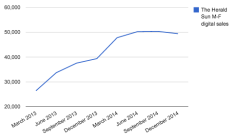
 Linkedin
Linkedin
It’s inevitable Fairfax will go to full paywalls. Advertising revenue is declining. There is not much they can do except cease print editions, which has been losing money, and set up a paywall and hope & pray the existing userbase will continue to use their sites, or simply divest themselves from the newspaper business altogether and buy into other forms of media such as tv and radio.
User ID not verified.
if it makes you feel any better, and it won’t, I got my online subscription for free as an advertiser. Ironic.
User ID not verified.
Don’t suppose you could make that subscription table expandable by clicking? As it is, it’s almost impossible to read on a desktop screen. Thanks!!
User ID not verified.
Hi JNK,
I’ve saved in a larger version of that table here: https://mumbrella.com.au/wp-content/uploads/2015/02/Screen-Shot-2015-02-13-at-9.08.25-am.png.
Cheers,
Tim – Mumbrella
I’m clearly one of the few bucking the trend, particular in terms of magazine readership (albeit digital mags).
I read more magazines and papers than I ever have. As well as the full suite of weekend papers that are delivered, and the daily, I read both major Victorian papers online. Plus with Zinio and others I’m subscribing to far more magazines than ever.
User ID not verified.
Yes. The hoops to jump through to set up a digital subscription are ridiculous. I gave up and just used incognito in my browser and didn’t bother renewing my digital subscription when it lapsed. I doubt I’m alone
User ID not verified.
I just ended my subscription and it was as difficult as you describe.
I was offered all kinds of deals to stay, but refused.
The content is terrible. A few decent stories and then fluff pieces about why we should stop talking about Robin Lawley’s body.
So many of my wonderful, intelligent friends have been made redundant by Fairfax and it shows.
User ID not verified.
Hi valethesmh,
Thanks for your comment. I do disagree on the content point. There still is a lot of great content, albeit perhaps less than in the past.
Cheers,
Tim – Mumbrella
How are Chrome’s Incognito sessions incorporated into web analytics? Could it be artificially increasing (albeit on a small scale) their Users/UBs/UAs?
User ID not verified.
The fact is newspapers lose on every metric:
• The news is slow.
• The news is not news – often regurgitated PR or copied from overseas
• The opinions are what the owner wants to push their own agenda
• Investigative journalism is dead
• There are far better blogs out there
The fact is the industry is about to have its Kodak moment and those who run it are too wedded to the past to see it.
User ID not verified.
The growth of free online alternatives, such as The Drum and other ABC content, makes it difficult to convince casual readers to pay for a subscription. Perhaps the ABC should be scaled back to more basic offerings, to give the struggling commercial alternatives a fighting chance.
User ID not verified.
Where is the Daily Telegraph in the table?
User ID not verified.
There are two things worth noting here. One is that the Fairfax editorial strength is a remnant. The next generation of McClymonts have gone or are going, just as Linton Besser has done. Management has zero focus on product and is largely resigned to accepting whatever the latest insight is from Corbett’s consultants.
The other thing worth noting is that the Fairfax digital product remains in the hands of infants who are eiher completely absorbed with tech fashion or, worse, are tryin to run everything on data (hence the idiotic processes and messaging that no professional would allow to be sampled in wireframe let alone released to the world).
The core problem at Fairfax is the people at the top and they are killing it faster than either News or the technology disruptors.
User ID not verified.
So agree about the Fairfax subscriber ‘services’ – they’re decidedly anti-user. I also subscribe to the AFR online – any query leads to a foreign help desk, and average response time (eg a question about account payment) is at least a week. They even send an automated email saying, “We haven’t forgotten you!” – as if that disguises the appalling lack of resources and response.
User ID not verified.
” Why do people talk about Nine – market cap $1.7bn – buying Fairfax? Given the comparative capitalisations, shouldn’t it be the other way round?”
Smaller companies take over larger companies all the time, look at the speculation of Glencore making a takeover for Rio for example (a smaller company that’s also in much more debt).
User ID not verified.
Tim,
Thanks for an interesting read – Why is it that publishers seemingly can’t find ways to innovate and care about the reader and subsequently the content those readers consume so more of us could become ‘rusted on’?
Subscribers are sent generic ‘front pages’, interests aren’t catered for and there’s an assumption that they’re too big to fail.
I’m generally perplexed, surely if they spent less time ‘massaging’ figures and more time understanding customers and building content (robust, with integrity, for a defined audience) they could turn this around.
I just can’t figure out, is it historical ‘church and state’ debates, a reluctance to change, an arrogance looking at where they have been, fear of losing short term revenue vs long term goals?
There’s plenty of smarts at News and Fairfax – the results really don’t demonstrate that though, as much as papers are ‘dying’ or in decline or whatever, these compainies are killing them.
User ID not verified.
Yes, Fairfax has a problem – but not so all newspapers. It is a pity to tar them all with the one brush. Many small community newspapers like mine are doing OK, thank you very much. While I suppose anyone could always do better, we continue to deliver effective advertising to our clients, most of whom are small local businesses with local clientele, and which don’t need their message to be spread over a wide area, or need to pay for that. The corner butchery needs to advertise its sausages, the local plumber needs to advertise her availability. We deliver clients to them, effectively and economically.
User ID not verified.
Hey Chris, is your “I just can’t figure out, is it historical ‘church and state’ debates” comment a way of pushing native (or advertorial in oldspeak). Don’t see how that would engage readers, or do advertisers know more than journos?.
User ID not verified.
Tim, where is SA’s The Advertiser?
User ID not verified.
Hi Anika,
The Advertiser is one of the News Corp titles that does not choose to publish audited paywall numbers.
Cheers,
Tim – Mumbrella
Can someone plz tell various levels of government what a waste of ad-spend print is?
Corporate welfare by stealth.
User ID not verified.
Perhaps, if the newspapers presented “news” instead of puffery, owners opinions and press releases, then perhaps people may vlue them and pay for the hard or soft version.
As it stands, newspapers are filled with advertorials and information that is worng, out of date or biased.
Murdoch said 2030 was the end, sadly hes right again, as they are now, papers will be gone by 2030
User ID not verified.
Hey Crizza,
Not really an advertorial/editorial debate – more a comment on how they are set in their ways – I don’t think we should advertorialise the book (not that you couldn’t place relevant ads on the right pages, that’s hardly offensive – I just think historical “this is the way its always been done” is how they make decisions rather than asking “how can we?”
An unwillingness to change. As much as papers are declining, the publishers are killing them.
User ID not verified.
You must be doing well if you can afford the rent I that building!
User ID not verified.
As a daily purchaser of the SMH (despite my tag), all I can say is consider the print alternatives! And I pay full whack since there are no deliveries when I live in Port Macquarie. The early deadlines are sometimes embarrassing compared with the Telegraph’s, but if you want up-to-the-minute news there are alternatives. Another gripe, despite paying $15 a week for the paper (much more than a subscription via delivery), I don’t get free access to the website. But then, as someone ahead of me said, that appears to be run by infants anyway.
User ID not verified.
If Fairfax goes under. . . what will you have to write about? We need to do more to protect Australian publishing or we will have nothing but international publications.
How are the Mumbrella online figures going?
User ID not verified.
Hi Claire,
Our audited Australian numbers are updated every month here: https://mumbrella.com.au/advertise
The most recent numbers for January are 11,173 daily UBs and 723,306 monthly page impressions.
Cheers,
Tim – Mumbrella
I think the mistake the newspaper industry has made with paywalls is to try and force people into an all you can eat arrangement in the form of lengthy subscriptions. This approach is simply irrelevant in the context of digital media and digital fragmentation for the not yet rusted on. What happened to micro-payments? With better strategy the traditional mastheads could have transitioned to the premium end of the digital market but instead they’ve double fisted themselves by offering an inflexible product and engaging in a race to the bottom in terms of content.
User ID not verified.
I worry that if newspapers and their digital personas fail who will be left to report on the news of the day? Yes there are some incredible blogs out there, producing excellent content, but it’s often quite specialised content. Who will cover the courts, parliament, local councils etc?
The problem is that the ad revenue has gone to Google (a company which apparently doesn’t pay its share of Aussie taxes) and to Facebook but neither actually invest money into reporting news.
It’s very easy to criticise the news organisations we have but who will you criticise when they’ve gone? And where will the ‘aggregator websites’ be without the organisations whose content they often pinch?
The other scary thing to watch are the most read story lists on the big news sites … it seems we’re headed to a future of stories about skateboarding mice and mutant pigs.
User ID not verified.
This might be an old idea, but make digital content worth while and cheap. And on print editions I prefer them , but instead of raising the price.
For example when the local paper here raised the price of the Sunday version to 2.50 I cancelled it. along with quite a few other people.
They tried dropping the price of the weekday issue a few years ago to $1.00, that worked but it has slowly crept back up again to $1.30…any more and I will just cancel.
User ID not verified.
Don’t forget that every second story is negative manipulated content. Depressing for the customer and too melodramatic for an educated reader
User ID not verified.
why all the hand wringing? ice deliverers and shit collectors, gone. buggy wheel manufacturers, gone.
so a 20th century business model goes the way of chimney sweeps.
it’ll be replaced by something better if history is any guide. stop worrying about it.
User ID not verified.
The age printing centre closed last year or so and now their are printing The Age in Ballarat in a smaller plant the had to cut the numbers of papers printed that is why the circulation dept. Is pushing the customers to join the digital version. It will not work .
User ID not verified.
Such a long article. And so very, very boring. I confess I didn’t read past the first few paras. Is anyone shocked that hard copies across the board are declining? It is such a natural progression from off to online. Oh the poor journos – NO – good journos will ALWAYS do well – its not the platform, its the content, stupid.
User ID not verified.
I am a news junkie. But newspapers are dead. They blew it. They had the chance to keep a small hardcore readership like me who would pay but in their insane belief they could find new younger readers went downmarket, hired 18 year olds with no institutional knowledge as reporters and treated us as idiots with short attention spans.
After a lifetime of news obsession, I don’t buy or read papers, don’t read local online sites and have stopped watching TV news which is next for extinction. My Facebook and Twitter friends alert me to anything I need to know.
User ID not verified.
Hasn’t Murdoch pretty much Destroyed Main Stream Media for everybody – I mean I would come here, e.g, first.
User ID not verified.
You can get nearly all the exact same smh / Age content for free at brisbanetimes.com.au- minus a couple of local stories. And there are no plans to introduce a paywall for that site. So why would anyone take up a digital subscription?
User ID not verified.
We’ll in Adelaide why would you pay for a digital subscription to the advertiser which only comes out with 1 or 2 decent unique articles and the occasional good opinion piece when you can read the excellent indaily.com.au for free and get all your other news from the abc news website
While I occasionally skim the advertiser because there’s a copy at work but there’s not enough in there that would make me want to spend money on it
User ID not verified.
I can only imagine that the idea of the early deadline for the print version is to force people online to get all those things that have happened in the evening that aren’t in the paper. But there’s a million sources of that news, and the conversion rate of print SMH readers to online SMH readers using that technique must be negligible. Anyone who wants to read the news in a newspaper is just being forced to buy The Australian or their local Murdoch tabloid.
User ID not verified.
I am a Fairfax fan and still think the content is really good. I get a 7-day print delivery and digital access. It is a significant saving on the shop price and well worth it. I think the key reason Fairfax print circ has declined so much (although as we know, ALL papers have declined) is the significant cover price increases over the last few years from $1.20 to $2.50 for M-F. Their competitor is almost half that price. But that was a business decision they claim is paying off in terms of increased profitability. If I was on the Fairfax management team I’d be pushing the savings that can be made from print & digital subscriptions, and why not bundle a discounted Stan subscription into the package?
Let’s also not forget, as I often point out on these boards because I don’t think it is recognised enough — the Sydney Morning Herald is still the most-read publication in Australia, according to EMMA. They beat the Tele by about a million readers. Most of this comes from digital. The Tele’s website rarely even makes the top 10.
User ID not verified.
Is Rupert Murdoch’s emotional connection with his rag’s, going to be their down fall? (As well as of course the trends we see affecting all print and digital news houses.)
Murdoch aggressively peddles his agenda and people are seeing through this, in the vastly more transparent world that exists today.
Will he get the flick and News Ltd becomes a bit more of a democracy, in terms of the management structure? Today Rupert is firmly in charge, down to the yield of the ad’s in the Daily Tele. believe you me he is, as he is in every country where he operates. Of course, when it came to the phone hacking payments, he conveniently wasn’t over the p&l…….
User ID not verified.
“I recommend washing your hands before reading if you’re the 19th in that queue.”
I’d wash my hands after too.
User ID not verified.
To paraphrase Mel Gibson: I didn’t leave Newspapers. Newspapers left me.
User ID not verified.
The pricing models for the papers are the problem … papers have always operated in a bloated environment and this fuels how they still believe access is worth $25-30 a month when Netflix is $8 and Stan is $10.
Consumer options
– all the recorded music in the world on demand for $10
– the majority of filmed content in the world for $10
– one newspapers content for $25-30
The pricing model just seems like a relic. The amount of indulgence the newspaper world seems to want to entertain is still out of control. The Australian Media Section is one example, most op-ed in the AFR is another.
User ID not verified.
Ok, hands up if you read a newspaper, are under the age of forty, and do not work in advertising?
User ID not verified.
Fairfax results reflect the fact that audiences are lost. Fairfax is trying to pump up the Domain “brand”, which is really just a carve out of real estate. But in doing so they highlight the fact that the remaining revenue in SMH, Age, CanTimes, AFR etc is largely unprofitable. Of course, most of that is print ads. So they can’t switch to digital for a profitable future.
The total collapse of these brands in terms of product quality is tragic.
User ID not verified.
Stan’s 100, 000 customers at 10 bucks a month divided by 2 (half goes to NEC) is a 6 million dollar a year business.
not taking into account royalties on the content, that might just be enought to cover 1 or 2 C level salaries at FXJ
User ID not verified.
Try subscribing to the UK Telegraph and it’s such a chore I gave up after an hour. Same with the UK Sunday Times and the same with the SMH. Yet The Australian got their digital subscription down to a tee several years ago and it’s there waiting on my computer for me in the morning.
I really want to subscribe to Fairfax but it’s such an ordeal I gave up.
User ID not verified.
I have a fewl free newspapers apps on my smart phone for basic news items during the week, the Daily Mail, the Guardian etc. I also have one or two paid for apps which give a slightly broader content offering. I also purchase the New York Times International on my kindle e reader 2,3 or 4 days per week depending on how much time I have to read it. I also buy the excellent London Times and Sunday Times a couple of times per week on Kindle. The only real ‘hard copy’ newspaper I buy these days is the Weekend Australian. Digital journalism is just so much easier to carry around with you, it’s a far more convenient platform.
I find some of the mainstream Australian newspaper smart phone apps don’t work very well so I don’t use them…
User ID not verified.
Firstly thanks for allowing me to comment.
Fairfax and Murdoch rarely allow such luxury.
Am an avid newshound and Google News sounded the death knell
for my print-buying. It can direct you to a wide variety of news sources shorly after the event occurs.
Fairfax has a pink agenda which can be off-putting to family types.
Michael West though does some great investigative pieces.
Murdoch’s style seems hell bent on bullying politicians into submission rather than entertaining readers.
User ID not verified.
The Australian is the encyclodepia of newspapers. The daily tele is fully of balanced, non commercial journalism. Both papers are credible and help inform the wider society.
😮
Why on earth should either of these papers be struggling?
User ID not verified.
@wide eyed and helpless –
Because, those media owners/publishers actually believe what you have written and assume that the public is as media stupid as it was 50 years ago.
User ID not verified.
@ wide eyed and helpless
My father in law rates The Australian as the ‘Rolls Royce’ of Newspapers. He has been institutionalised by years of propaganda by the Murdoch press and the ‘policy for the bigots and bogans’ strategy they emit. He is actually quite smart, however it is in his blood now. Very sad.
Will Murdoch’s influence subside due to digital channels and social media? Are then any credible studies or insights and forecasts around this?
User ID not verified.
Are there any*
User ID not verified.